radio BUICK TERRAZA 2007 Owner's Manual
[x] Cancel search | Manufacturer: BUICK, Model Year: 2007, Model line: TERRAZA, Model: BUICK TERRAZA 2007Pages: 562, PDF Size: 2.96 MB
Page 98 of 562
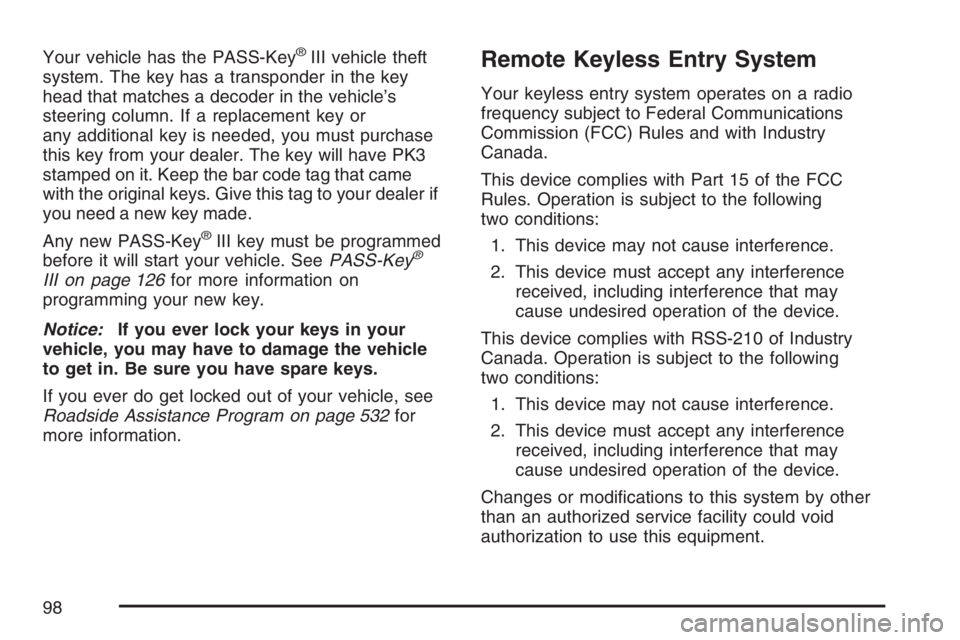
Your vehicle has the PASS-Key®III vehicle theft
system. The key has a transponder in the key
head that matches a decoder in the vehicle’s
steering column. If a replacement key or
any additional key is needed, you must purchase
this key from your dealer. The key will have PK3
stamped on it. Keep the bar code tag that came
with the original keys. Give this tag to your dealer if
you need a new key made.
Any new PASS-Key
®III key must be programmed
before it will start your vehicle. SeePASS-Key®
III on page 126for more information on
programming your new key.
Notice:If you ever lock your keys in your
vehicle, you may have to damage the vehicle
to get in. Be sure you have spare keys.
If you ever do get locked out of your vehicle, see
Roadside Assistance Program on page 532for
more information.
Remote Keyless Entry System
Your keyless entry system operates on a radio
frequency subject to Federal Communications
Commission (FCC) Rules and with Industry
Canada.
This device complies with Part 15 of the FCC
Rules. Operation is subject to the following
two conditions:
1. This device may not cause interference.
2. This device must accept any interference
received, including interference that may
cause undesired operation of the device.
This device complies with RSS-210 of Industry
Canada. Operation is subject to the following
two conditions:
1. This device may not cause interference.
2. This device must accept any interference
received, including interference that may
cause undesired operation of the device.
Changes or modi�cations to this system by other
than an authorized service facility could void
authorization to use this equipment.
98
Page 126 of 562
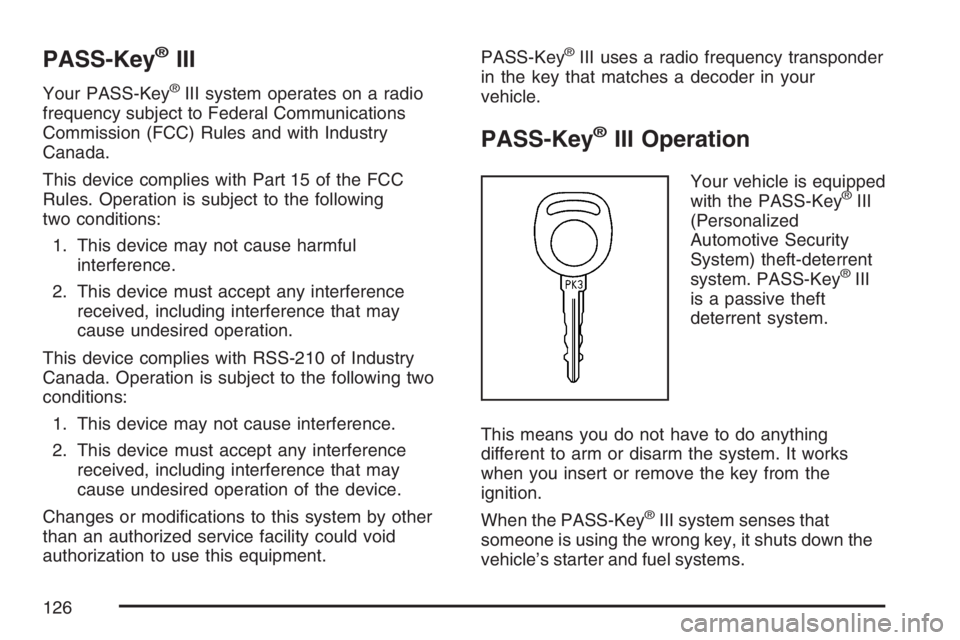
PASS-Key®III
Your PASS-Key®III system operates on a radio
frequency subject to Federal Communications
Commission (FCC) Rules and with Industry
Canada.
This device complies with Part 15 of the FCC
Rules. Operation is subject to the following
two conditions:
1. This device may not cause harmful
interference.
2. This device must accept any interference
received, including interference that may
cause undesired operation.
This device complies with RSS-210 of Industry
Canada. Operation is subject to the following two
conditions:
1. This device may not cause interference.
2. This device must accept any interference
received, including interference that may
cause undesired operation of the device.
Changes or modi�cations to this system by other
than an authorized service facility could void
authorization to use this equipment.PASS-Key
®III uses a radio frequency transponder
in the key that matches a decoder in your
vehicle.
PASS-Key®III Operation
Your vehicle is equipped
with the PASS-Key®III
(Personalized
Automotive Security
System) theft-deterrent
system. PASS-Key
®III
is a passive theft
deterrent system.
This means you do not have to do anything
different to arm or disarm the system. It works
when you insert or remove the key from the
ignition.
When the PASS-Key
®III system senses that
someone is using the wrong key, it shuts down the
vehicle’s starter and fuel systems.
126
Page 129 of 562
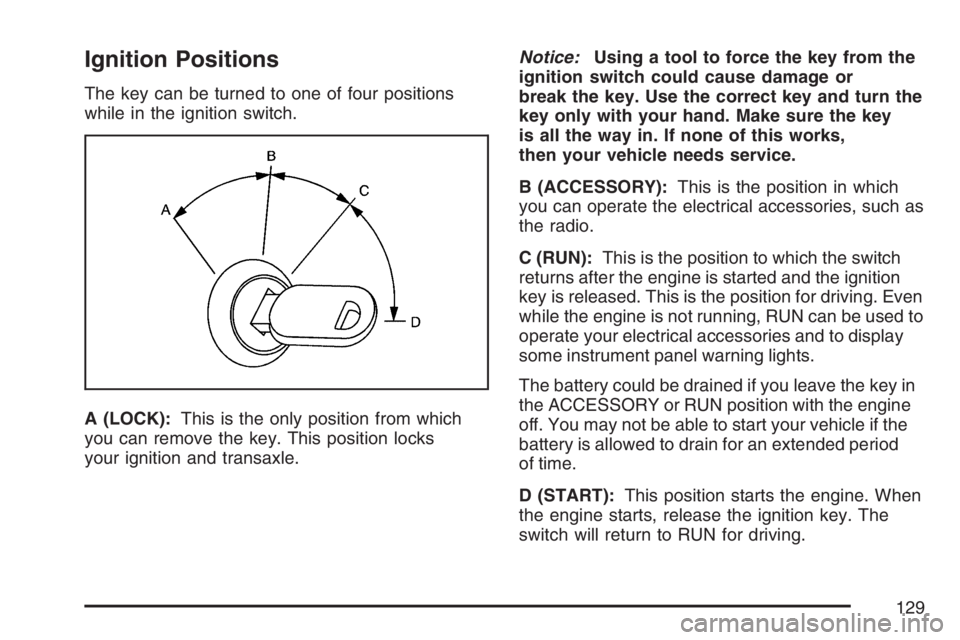
Ignition Positions
The key can be turned to one of four positions
while in the ignition switch.
A (LOCK):This is the only position from which
you can remove the key. This position locks
your ignition and transaxle.Notice:Using a tool to force the key from the
ignition switch could cause damage or
break the key. Use the correct key and turn the
key only with your hand. Make sure the key
is all the way in. If none of this works,
then your vehicle needs service.
B (ACCESSORY):This is the position in which
you can operate the electrical accessories, such as
the radio.
C (RUN):This is the position to which the switch
returns after the engine is started and the ignition
key is released. This is the position for driving. Even
while the engine is not running, RUN can be used to
operate your electrical accessories and to display
some instrument panel warning lights.
The battery could be drained if you leave the key in
the ACCESSORY or RUN position with the engine
off. You may not be able to start your vehicle if the
battery is allowed to drain for an extended period
of time.
D (START):This position starts the engine. When
the engine starts, release the ignition key. The
switch will return to RUN for driving.
129
Page 147 of 562
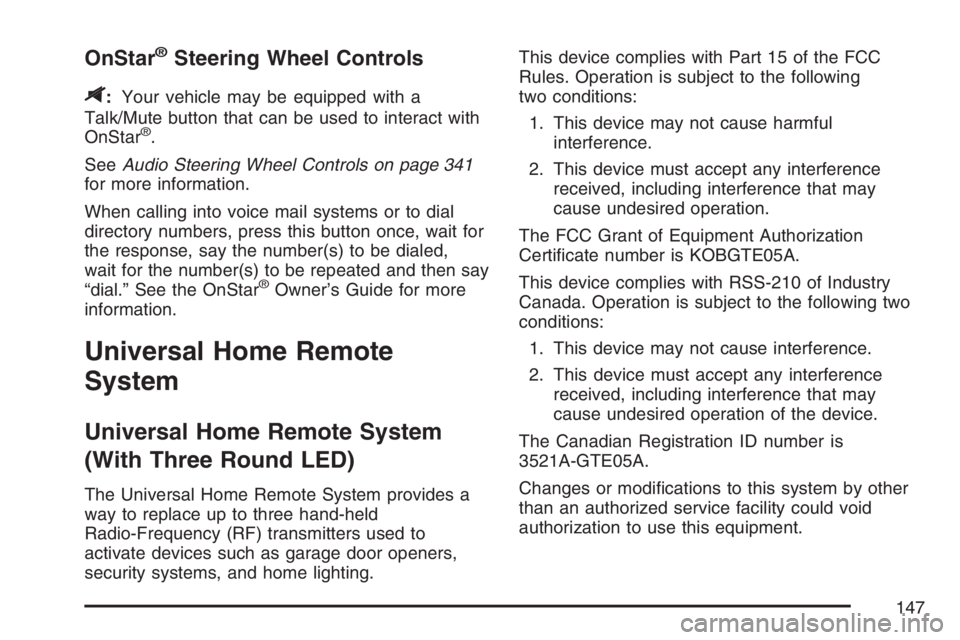
OnStar®Steering Wheel Controls
$
:Your vehicle may be equipped with a
Talk/Mute button that can be used to interact with
OnStar
®.
SeeAudio Steering Wheel Controls on page 341
for more information.
When calling into voice mail systems or to dial
directory numbers, press this button once, wait for
the response, say the number(s) to be dialed,
wait for the number(s) to be repeated and then say
“dial.” See the OnStar
®Owner’s Guide for more
information.
Universal Home Remote
System
Universal Home Remote System
(With Three Round LED)
The Universal Home Remote System provides a
way to replace up to three hand-held
Radio-Frequency (RF) transmitters used to
activate devices such as garage door openers,
security systems, and home lighting.This device complies with Part 15 of the FCC
Rules. Operation is subject to the following
two conditions:
1. This device may not cause harmful
interference.
2. This device must accept any interference
received, including interference that may
cause undesired operation.
The FCC Grant of Equipment Authorization
Certi�cate number is KOBGTE05A.
This device complies with RSS-210 of Industry
Canada. Operation is subject to the following two
conditions:
1. This device may not cause interference.
2. This device must accept any interference
received, including interference that may
cause undesired operation of the device.
The Canadian Registration ID number is
3521A-GTE05A.
Changes or modi�cations to this system by other
than an authorized service facility could void
authorization to use this equipment.
147
Page 148 of 562
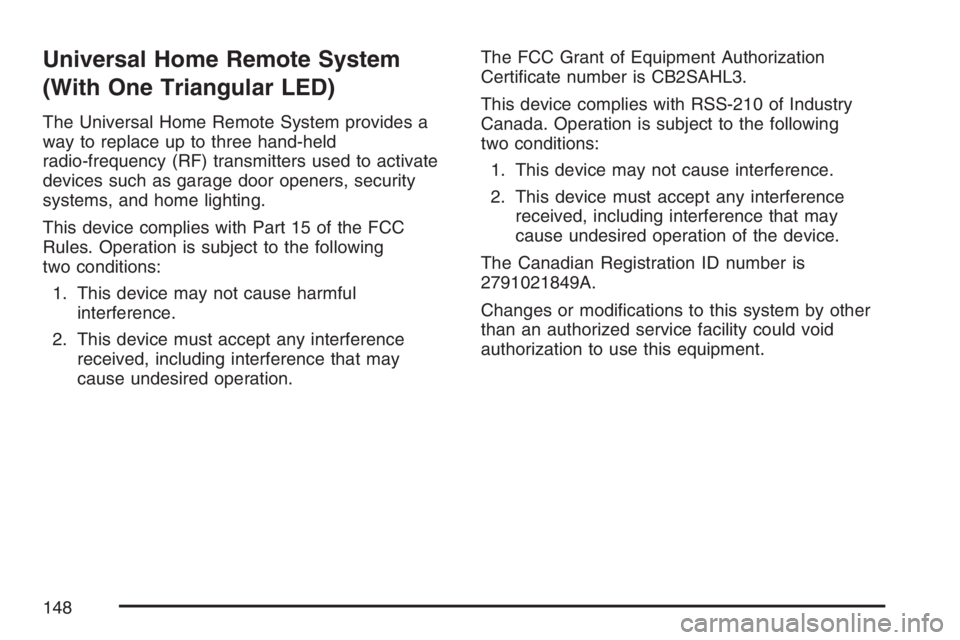
Universal Home Remote System
(With One Triangular LED)
The Universal Home Remote System provides a
way to replace up to three hand-held
radio-frequency (RF) transmitters used to activate
devices such as garage door openers, security
systems, and home lighting.
This device complies with Part 15 of the FCC
Rules. Operation is subject to the following
two conditions:
1. This device may not cause harmful
interference.
2. This device must accept any interference
received, including interference that may
cause undesired operation.The FCC Grant of Equipment Authorization
Certi�cate number is CB2SAHL3.
This device complies with RSS-210 of Industry
Canada. Operation is subject to the following
two conditions:
1. This device may not cause interference.
2. This device must accept any interference
received, including interference that may
cause undesired operation of the device.
The Canadian Registration ID number is
2791021849A.
Changes or modi�cations to this system by other
than an authorized service facility could void
authorization to use this equipment.
148
Page 155 of 562
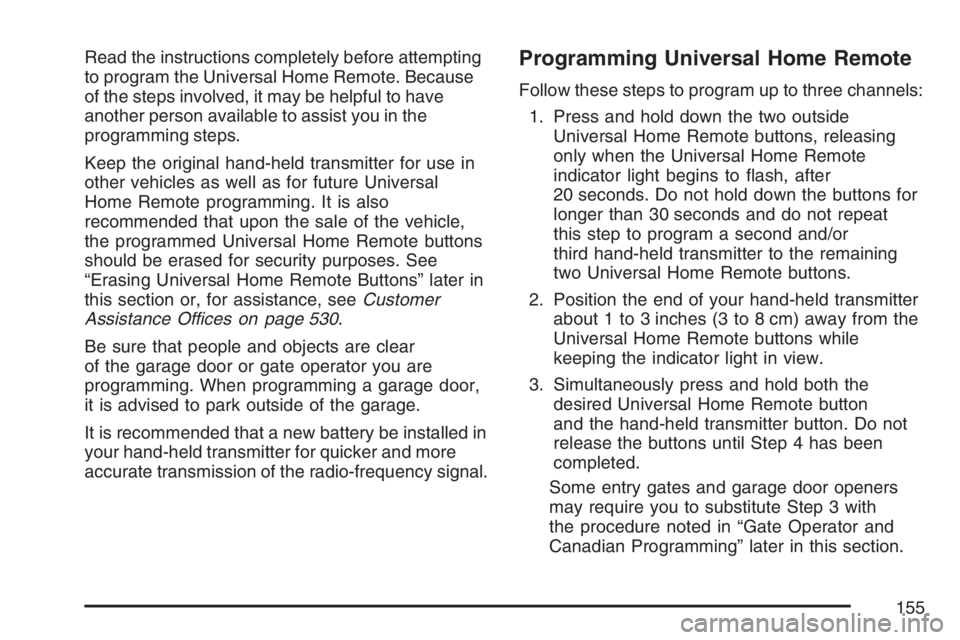
Read the instructions completely before attempting
to program the Universal Home Remote. Because
of the steps involved, it may be helpful to have
another person available to assist you in the
programming steps.
Keep the original hand-held transmitter for use in
other vehicles as well as for future Universal
Home Remote programming. It is also
recommended that upon the sale of the vehicle,
the programmed Universal Home Remote buttons
should be erased for security purposes. See
“Erasing Universal Home Remote Buttons” later in
this section or, for assistance, seeCustomer
Assistance Offices on page 530.
Be sure that people and objects are clear
of the garage door or gate operator you are
programming. When programming a garage door,
it is advised to park outside of the garage.
It is recommended that a new battery be installed in
your hand-held transmitter for quicker and more
accurate transmission of the radio-frequency signal.Programming Universal Home Remote
Follow these steps to program up to three channels:
1. Press and hold down the two outside
Universal Home Remote buttons, releasing
only when the Universal Home Remote
indicator light begins to �ash, after
20 seconds. Do not hold down the buttons for
longer than 30 seconds and do not repeat
this step to program a second and/or
third hand-held transmitter to the remaining
two Universal Home Remote buttons.
2. Position the end of your hand-held transmitter
about 1 to 3 inches (3 to 8 cm) away from the
Universal Home Remote buttons while
keeping the indicator light in view.
3. Simultaneously press and hold both the
desired Universal Home Remote button
and the hand-held transmitter button. Do not
release the buttons until Step 4 has been
completed.
Some entry gates and garage door openers
may require you to substitute Step 3 with
the procedure noted in “Gate Operator and
Canadian Programming” later in this section.
155
Page 157 of 562
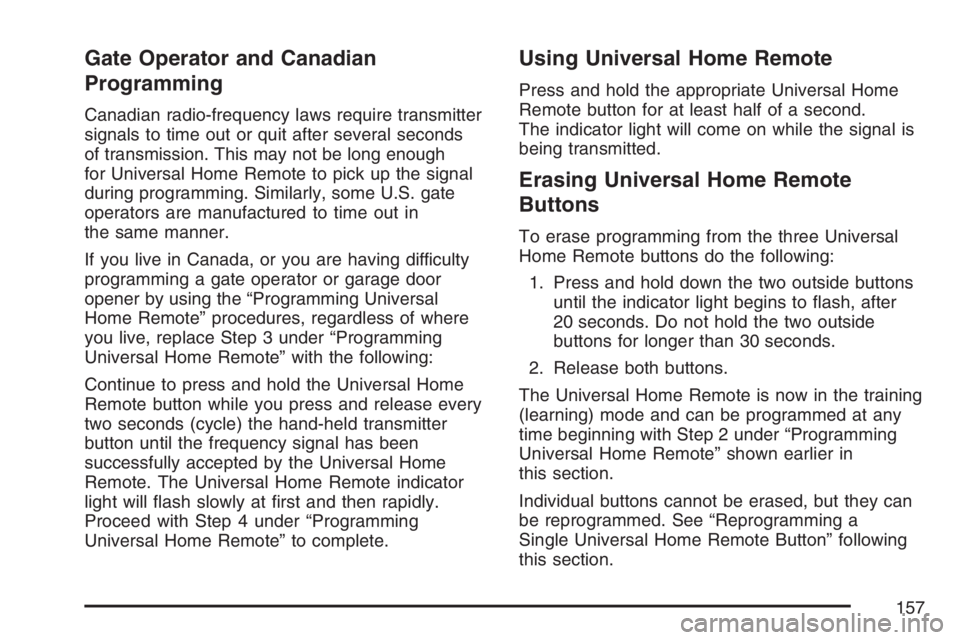
Gate Operator and Canadian
Programming
Canadian radio-frequency laws require transmitter
signals to time out or quit after several seconds
of transmission. This may not be long enough
for Universal Home Remote to pick up the signal
during programming. Similarly, some U.S. gate
operators are manufactured to time out in
the same manner.
If you live in Canada, or you are having difficulty
programming a gate operator or garage door
opener by using the “Programming Universal
Home Remote” procedures, regardless of where
you live, replace Step 3 under “Programming
Universal Home Remote” with the following:
Continue to press and hold the Universal Home
Remote button while you press and release every
two seconds (cycle) the hand-held transmitter
button until the frequency signal has been
successfully accepted by the Universal Home
Remote. The Universal Home Remote indicator
light will �ash slowly at �rst and then rapidly.
Proceed with Step 4 under “Programming
Universal Home Remote” to complete.
Using Universal Home Remote
Press and hold the appropriate Universal Home
Remote button for at least half of a second.
The indicator light will come on while the signal is
being transmitted.
Erasing Universal Home Remote
Buttons
To erase programming from the three Universal
Home Remote buttons do the following:
1. Press and hold down the two outside buttons
until the indicator light begins to �ash, after
20 seconds. Do not hold the two outside
buttons for longer than 30 seconds.
2. Release both buttons.
The Universal Home Remote is now in the training
(learning) mode and can be programmed at any
time beginning with Step 2 under “Programming
Universal Home Remote” shown earlier in
this section.
Individual buttons cannot be erased, but they can
be reprogrammed. See “Reprogramming a
Single Universal Home Remote Button” following
this section.
157
Page 168 of 562
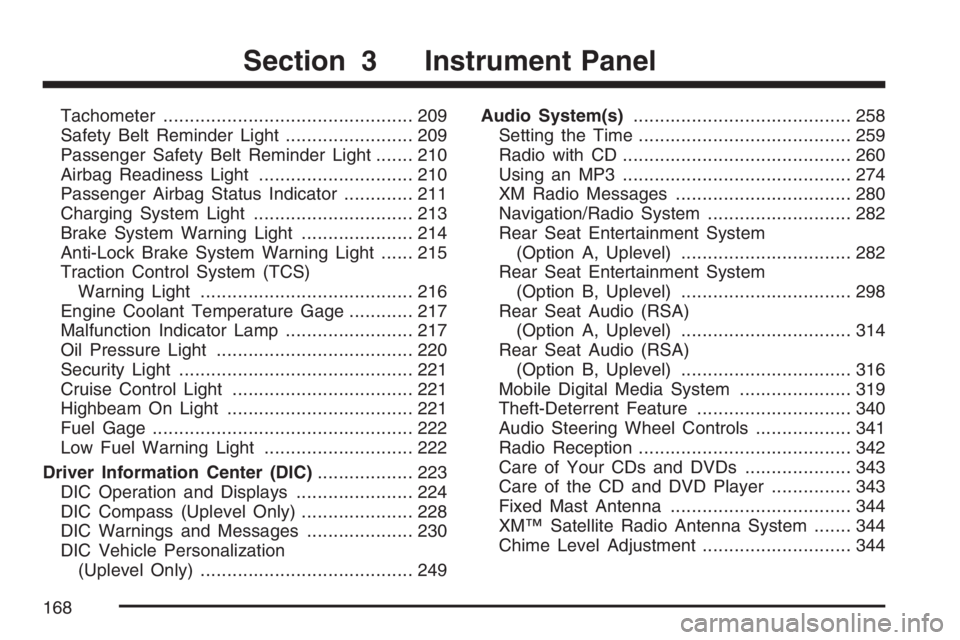
Tachometer............................................... 209
Safety Belt Reminder Light........................ 209
Passenger Safety Belt Reminder Light....... 210
Airbag Readiness Light............................. 210
Passenger Airbag Status Indicator............. 211
Charging System Light.............................. 213
Brake System Warning Light..................... 214
Anti-Lock Brake System Warning Light...... 215
Traction Control System (TCS)
Warning Light........................................ 216
Engine Coolant Temperature Gage............ 217
Malfunction Indicator Lamp........................ 217
Oil Pressure Light..................................... 220
Security Light............................................ 221
Cruise Control Light.................................. 221
Highbeam On Light................................... 221
Fuel Gage................................................. 222
Low Fuel Warning Light............................ 222
Driver Information Center (DIC).................. 223
DIC Operation and Displays...................... 224
DIC Compass (Uplevel Only)..................... 228
DIC Warnings and Messages.................... 230
DIC Vehicle Personalization
(Uplevel Only)........................................ 249Audio System(s)......................................... 258
Setting the Time........................................ 259
Radio with CD........................................... 260
Using an MP3........................................... 274
XM Radio Messages................................. 280
Navigation/Radio System........................... 282
Rear Seat Entertainment System
(Option A, Uplevel)................................ 282
Rear Seat Entertainment System
(Option B, Uplevel)................................ 298
Rear Seat Audio (RSA)
(Option A, Uplevel)................................ 314
Rear Seat Audio (RSA)
(Option B, Uplevel)................................ 316
Mobile Digital Media System..................... 319
Theft-Deterrent Feature............................. 340
Audio Steering Wheel Controls.................. 341
Radio Reception........................................ 342
Care of Your CDs and DVDs.................... 343
Care of the CD and DVD Player............... 343
Fixed Mast Antenna.................................. 344
XM™ Satellite Radio Antenna System....... 344
Chime Level Adjustment............................ 344
Section 3 Instrument Panel
168
Page 191 of 562
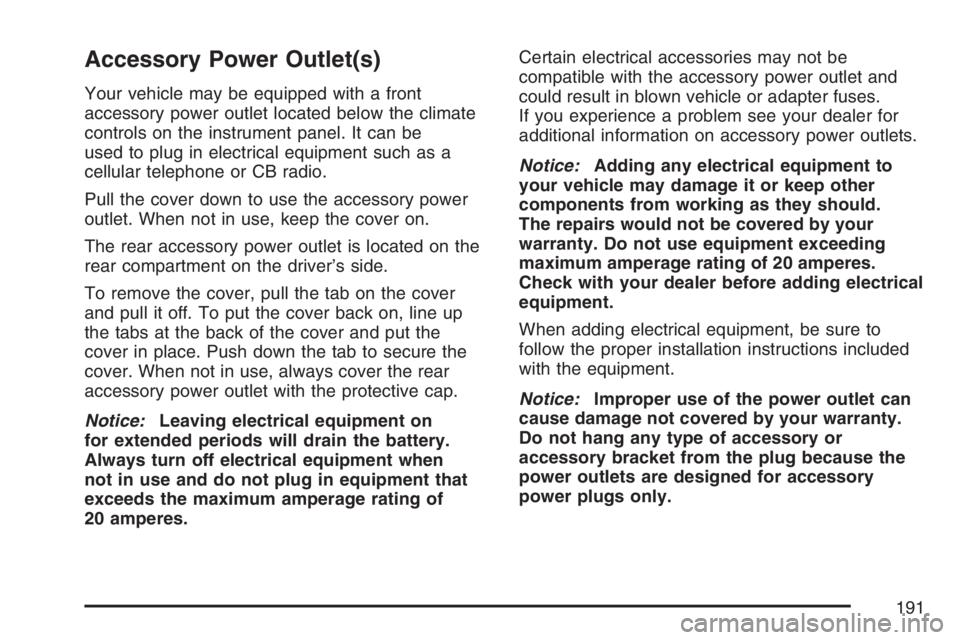
Accessory Power Outlet(s)
Your vehicle may be equipped with a front
accessory power outlet located below the climate
controls on the instrument panel. It can be
used to plug in electrical equipment such as a
cellular telephone or CB radio.
Pull the cover down to use the accessory power
outlet. When not in use, keep the cover on.
The rear accessory power outlet is located on the
rear compartment on the driver’s side.
To remove the cover, pull the tab on the cover
and pull it off. To put the cover back on, line up
the tabs at the back of the cover and put the
cover in place. Push down the tab to secure the
cover. When not in use, always cover the rear
accessory power outlet with the protective cap.
Notice:Leaving electrical equipment on
for extended periods will drain the battery.
Always turn off electrical equipment when
not in use and do not plug in equipment that
exceeds the maximum amperage rating of
20 amperes.Certain electrical accessories may not be
compatible with the accessory power outlet and
could result in blown vehicle or adapter fuses.
If you experience a problem see your dealer for
additional information on accessory power outlets.
Notice:Adding any electrical equipment to
your vehicle may damage it or keep other
components from working as they should.
The repairs would not be covered by your
warranty. Do not use equipment exceeding
maximum amperage rating of 20 amperes.
Check with your dealer before adding electrical
equipment.
When adding electrical equipment, be sure to
follow the proper installation instructions included
with the equipment.
Notice:Improper use of the power outlet can
cause damage not covered by your warranty.
Do not hang any type of accessory or
accessory bracket from the plug because the
power outlets are designed for accessory
power plugs only.
191
Page 213 of 562
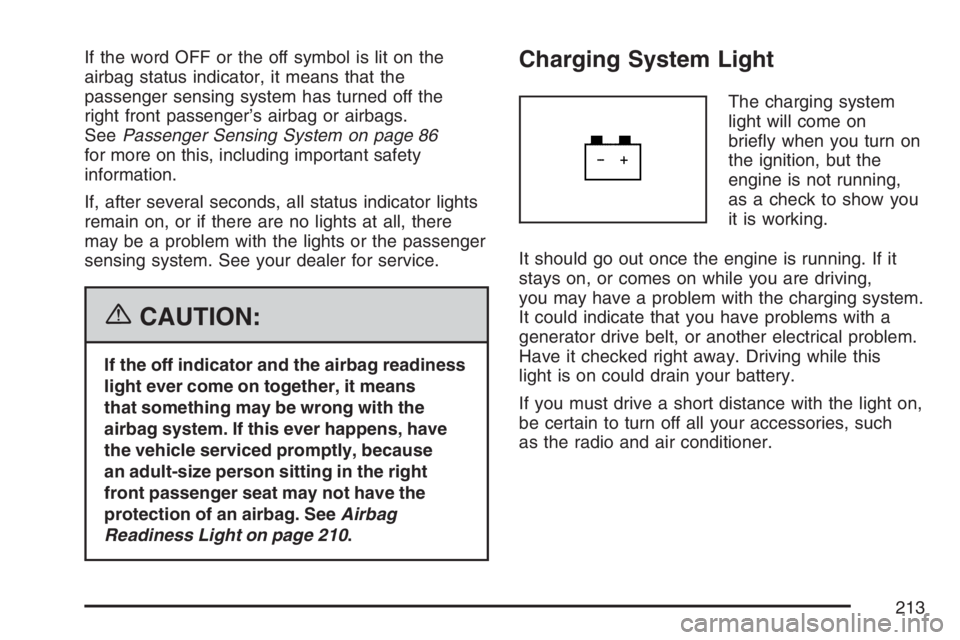
If the word OFF or the off symbol is lit on the
airbag status indicator, it means that the
passenger sensing system has turned off the
right front passenger’s airbag or airbags.
SeePassenger Sensing System on page 86
for more on this, including important safety
information.
If, after several seconds, all status indicator lights
remain on, or if there are no lights at all, there
may be a problem with the lights or the passenger
sensing system. See your dealer for service.
{CAUTION:
If the off indicator and the airbag readiness
light ever come on together, it means
that something may be wrong with the
airbag system. If this ever happens, have
the vehicle serviced promptly, because
an adult-size person sitting in the right
front passenger seat may not have the
protection of an airbag. SeeAirbag
Readiness Light on page 210.
Charging System Light
The charging system
light will come on
brie�y when you turn on
the ignition, but the
engine is not running,
as a check to show you
it is working.
It should go out once the engine is running. If it
stays on, or comes on while you are driving,
you may have a problem with the charging system.
It could indicate that you have problems with a
generator drive belt, or another electrical problem.
Have it checked right away. Driving while this
light is on could drain your battery.
If you must drive a short distance with the light on,
be certain to turn off all your accessories, such
as the radio and air conditioner.
213